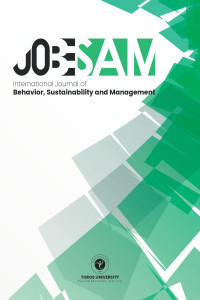FREIGHT TRANSPORTATION AND THE COVID-19 OUTBREAK: FRESH INSIGHTS FROM THE US ECONOMY
Freight Transportation, COVID-19, Toda-Yamamoto, United States
___
- Açıkgöz, Ö., & Günay, A. (2020). They early impact of the Covid-19 pandemic on the global and Turkish economy. Turkish journal of medical sciences, 50 (SI-1), 520–526.
- Bartle, J.R., Lutte, R.K., & Leuenberger, D.Z. (2021). Sustainability and air freight transportation: Lessons from the global pandemic. Sustainability, 13, 3738.
- Beyzatlar, M.A.; Karacal, M., & Yetkiner, H. (2014). Granger-causality between transportation and GDP: A panel data approach. Transp. Res. Part A Policy Pract., 63, 43–55.
- Beyzatlar, M. A., & Yetkiner, H. (2017). Convergence in transportation measures across the EU-15. Transportation, 44(5), 927–940.
- Boettke, P.J., & Powell, B. (2021) The political economy of the Covid-19 pandemic. Southern Economic Journal, 87(4), 1090– 1106.
- Bombelli, A. (2020). Integrators' Global Networks: A Topology Analysis with Insights into The Effect of the COVID-19 Pandemic. J. Transport Geogr. 87, 102815.
- Bouali, S., Douha, S., & Khadri, N. (2020). To what extent is air freight affected by the Corona virus pandemic? Journal of Sustainable Development of Transport and Logistics, 5(2), 98-108.
- Cui, Q., L. He, Y. Liu, Y. Zheng, W. Wei, B. Yang, & M. Zhou. (2021). “Measuring the Impacts of the COVID-19 Pandemic on China’s Transport Sectors Based on the CGE Model Coupled with a Decomposition Analysis Approach.” Transport Policy.
- Danisman, M., & Akkartal, E. (2020). Effects of Covid-19 Pandemy Over Maritime Transport: An Evaluation of Supply-Demand Balance. Archives of Business Research, 8(12). 83-97.
- De Vos, J.(2020). The effect of COVID-19 and subsequent social distancing on travel behavior. Transport. Res. Interdiscip. Perspect. 5, 100121.
- European Commission Directorate-General for Mobility and Transport, (2019). Transport in the European Union: Current Trends and Issues.
- Granger, C. (1969). Investigating causal relations by econometric models and cross spectral methods. Econometrica 37, 424–438.
- Gray, R., & Torshizi, M. (2021). Update to agriculture, transportation, and the COVID-19 crisis. Canadian Journal of Agricultural Economics/Revue canadienned’agroeconomie, 69(2).
- Ho, S.J., Xing, W., Wu, W., &Lee, C.C., (2021). The impact of COVID-19 on freight transport: Evidence from China. MethodsX 101200.
- Ivanov, D. (2020). Predicting the impacts of epidemic outbreaks on global supply chains: a simulation-based analysis on the coronavirus outbreak (COVID-19/SARS-CoV-2) case. Transp. Res. E Logist. Transp. Rev. 136, 101922.
- Li, T. (2020) A SWOT analysis of China’s air cargo sector in the context of COVID-19 pandemic. J. Air Transp. Manag., 88, 101875.
- Loske, D. (2020). The impact of COVID-19 on transport volume and freight capacity dynamics: An empirical analysis in German food retail logistics. Transport. Res. Interdiscip. Perspect. 6, 100165.
- Maliszewska, M., Mattoo, A., & Van Der Mensbrugghe, D. (2020). The potential impact of COVID19 on GDP and trade: A preliminary assessment, Policy Research Working Paper 9211, The World Bank.
- Mavrotas, G., &Kelly, R., 2001. Old wine in new bottle: testing causality between savings and growth. The Manchester School Supplement, pp. 97–105.
- Nwokedi T.C., Okoroji L.I., Nwoloziri C.N., Efanga H.O., &Okafor C.O. (2021). COVID-19: Disruption of Container Freight Transportation on Last Mile Corridors between Regional Hub Ports and Hinterland Markets in Nigeria, Hmlyan Jr Eco Bus Mgn; 2(1) 1-13.
- Osotimehin, S., & Popov L. (2020). Sectoral Impact of COVID-19: Cascading Risks (No.31). Federal Reserve Bank of Minneapolis.
- Toda, H. Y. and Yamamoto T. (1995), Statistical Inferences in Vector Autoregressions with Possibly Integrated Processes. Journal of Econometrics, 66, 225‐250.
- Vida, L., Illés, B., & Bányainé Tóth, Ágota. (2021). Preventing The Negative Effects of the COVID-19 Epidemic in International Freight Transport. Advanced Logistic Systems Theory and Practice, 14(1), 5-13.
- Yetkiner, H., & Beyzatlar, M.A. (2020). The Granger-causality between wealth and transportation: A panel data approach. Transp. Policy, 97, 19–25.
- Yayın Aralığı: Yılda 2 Sayı
- Başlangıç: 2023
- Yayıncı: Toros Üniversitesi
FREIGHT TRANSPORTATION AND THE COVID-19 OUTBREAK: FRESH INSIGHTS FROM THE US ECONOMY
Esranur YILMAZ, Mehmet Aldonat BEYZATLAR
SIVILAŞTIRILMIŞ DOĞAL GAZ TAŞIMA YOLLARININ AĞ TABANLI OPTİMİZASYONU
RESEARCH ON SUSTAINABLE CRITERIA AFFECTING THE LOGISTICS SECTOR
COPRAS ve EDAS Yöntemleriyle Yeşil Tedarikçi Seçimi
JAPONYA'DA SÜRDÜRÜLEBİLİR LOJİSTİK İÇİN MAKİNE ÖĞRENİMİ İLE YÜKSEK KAPASİTELİ ARAÇLARIN VERİ ANALİZİ
